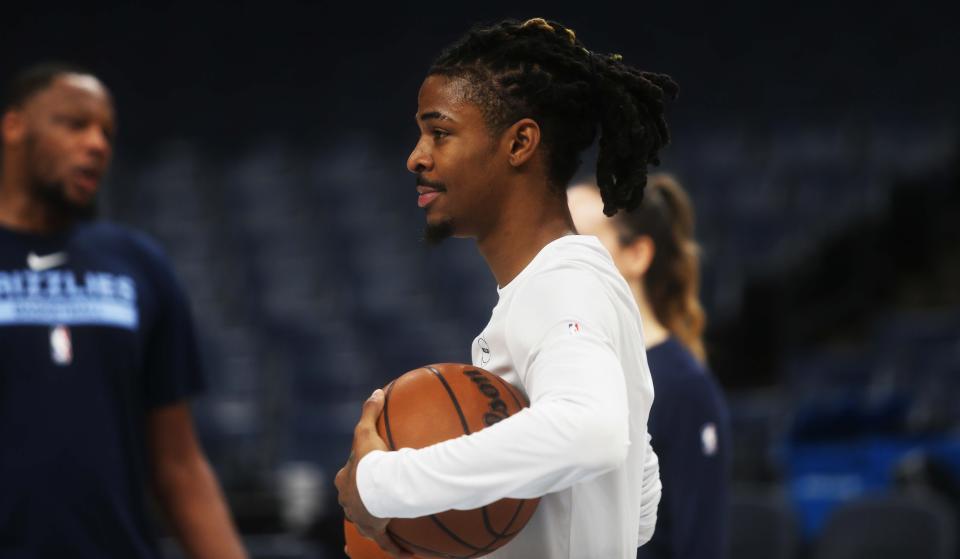Doctor explains Ja Morant's labral tear, how much time Memphis Grizzlies star could miss

Ja Morant's name mysteriously appeared on the injury report ahead of Sunday's game against the Phoenix Suns.
There were no signs two days earlier after beating the Los Angeles Lakers that the Memphis Grizzlies star point guard was dealing with anything serious. But after Morant sustained a subluxation in his shoulder during a training session the next day, it was determined he suffered a labral tear and would miss the remainder of the NBA season.
Morant, 24, is expected to make a full recovery.
The Commercial Appeal conducted a phone interview with Brian Schulz, an orthopedic surgeon at Cedars-Sinai Kerlan-Jobe Institute in Los Angeles who is also a team physician with the NHL's Anaheim Ducks and MLB's Los Angeles Angels. Schulz specializes in arthroscopic and open surgical techniques for sports related injuries to the knee, hip, elbow and shoulder.
Here is what Schulz said on Morant's injury, recovery process and long-term future.
What is a labral tear?
CA: The Grizzlies said that a MRI revealed a labral tear. How would you describe the labral?
Schulz: The labral is almost like a bumper when you're bowling and people put up the bumpers. The bumper keeps the ball on the track. The labrum tries to keep the ball in the socket, and the shoulder socket is a pretty shallow joint. It's not as confined as a hip joint. The labrum deepens the socket and keeps the ball in the center of the socket. If the ball gets pushed either out the front, back or bottom, the labrum tries to keep it from fully going over. The issue is that if that labrum exceeds what the labrum is capable of handling, it can pull the labrum away from the bone.
CA: How do you explain Ja Morant's shoulder subluxation from Saturday?
Schulz: To sublux your shoulder, essentially you have to be either really loose jointed or you have to injure the labrum for the ball to get even partially out. Once the labrum is injured, that bumper system has been altered, so it can't do the job that it used to be able to do, and the ball becomes even more loose, putting him at more risk of having additional subluxation or even dislocation. Every time that happens, you're risking further injury to the labrum, to the bone, to the cartilage in the joint.
CA: Is this injury more common to occur because of a workload, or could this be more because of an isolated incident?
Schulz: It can happen in one play, in one instance, or it can be wear-and-tear and be cumulative. When you're talking about baseball players, it's usually cumulative wear and tear. They're throwing over and over and that's putting stress on the labrum. In football, it's usually more traumatic, where the arm is in a funny position and it gets driven a way it shouldn't.
Ja Morant injury recovery timeline
CA: What does the recovery process look like for Ja Morant?
Schulz: At the surgery, they'll repair the labrum back to where it's supposed to be. He'll start physical therapy almost immediately after that, but you have to let that labrum heal, so there's certain movements and activities that they're going to need to avoid. In the normal person, that's going to take 2-to-3 months. He's an elite athlete. He may recover a little faster, but you don't want to rush that timeline because if you rush it too much, you get burned and he has to start over or gets hurt worse. Once he makes it to that kind of 2-to-3 month part if everything is going well, then they start strengthening all the muscles around his shoulder that they weren't able to initially.
CA: How long do you think it'll be before Morant can return to full basketball activity with no restrictions?
Schulz: Typically from this, even in an elite athlete, you're looking at an average return to play around six months, which is probably why they're saying he's done for the season.
Examining the long-term future of Ja Morant
CA: Are there any lingering or long-term affects Ja Morant could experience when this is done?
Schulz: There's always a chance he can be a little stiff or continue to have residual pain. I think more than likely, the odds are heavily in his favor that when he gets back on the court next season, he's not even going to be thinking about his shoulder.
CA: What is the mental hurdle with this kind of injury?
Schulz: Certainly, there's going to be a mental component to any injury. Everybody is going to be different with that. I wouldn't be too worried about it.
CA: Do you think he'll need to wear a shoulder brace or protection when he returns?
Schulz: It's case by case, but I wouldn't expect him to wear it for a couple of reasons. One, it will restrict his motion, which makes it hard for him to do what he needs to do. I would expect for him to return and not have it on, but it's a case by case basis.
This article originally appeared on Memphis Commercial Appeal: Doctor explains Memphis Grizzlies star Ja Morant's labral tear, timeline
